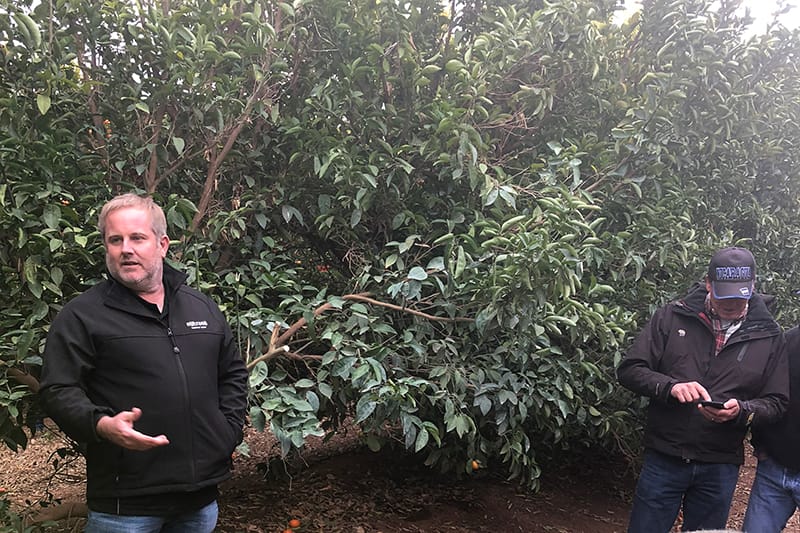09 August 2018
Afourer expertise the flavour of the month
Afourer expertise the flavour of the month
09 August 2018
A group of almost 50 growers and industry representatives gathered in July to hear guest speakers discuss Afourer pruning and management.

David Stevens, Chair of the Murray Valley Regional Advisory Committee and Citrus consultant at Nutrano, described the different pruning techniques currently adopted to increase crop load in older trees.
Representatives from US company, Sun Pacific Farming, were featured among the speakers, alongside David Stevens from Nutrano, John Chavarria from Mildura Fruit Company and other local experts.
Organised by the Murray Valley Regional Advisory Committee (MVRAC), the workshop took place at Nutrano Sunwest and included tours of the Nutrano equipment shed and Nutrano Afourer trial patch.
Sun Pacific representatives revealed that current pruning techniques on their farms involve:
- Establishing tree spacing wide enough to allow light penetration and shoots
- Pruning to open up the centre of the tree
- Blending shoots/suckers to allow maximum light inside the tree
- Responding to production cycles and regimes
- Monitoring production trends
- Adopting techniques from Spain
John Chavarria stressed the need to crop the trees well enough without being too excessive. Many at the workshop agreed that 50-60t/ha of crop load was an ideal target.
Sun Pacific described that crop levels are higher where there is a high fertiliser input, highlighting that healthy, strong trees will set more fruit, while weak trees will set less fruit.
MVRAC Chairman and Nutrano representative, David Stephens, described that Gibberellic Acid (GA) spraying works well in Australian conditions for setting flowers. David advised that in a light year, growers should observe flower petals to assess if and when to apply a GA spray. Weak flowers with petals that are not touching can be indications that a GA spray is necessary to set fruit and should be applied around petal fall.
Other recommendations from guest speakers included:
- Maximising light using heavy pruning to the inside and lower part of the tree is key to crop load – the ultimate goal is to chase more light as the natural growing pattern of these trees is to shade themselves out
- Select picking for size helps spread out crop loads from year to year
- The importance of good spacing when planting new trees; double planting is not recommended as close plantings cause the tree to grow more vigorously and this can’t be trained out of the tree later
- Stumping every second tree; one-sided hedging and managing regrowth has helped to increase crop load on trees over 10 years old
- Using V shape pruning techniques for older trees to increase vigour and growth has been trialled by an Australian grower over 2-3 years and is slowly working
The key messages taken home from the workshop were that:
- Future plantings should allow full grown trees to have light all around the tree – a wall approach is not effective long-term for this variety
- USA growers are going back to 6m x 3m spacings – some even wider
- Trees should be pruned from a young age
- Aim to set a steady crop load, don’t get into biennial bearing by failing to manage the crop load earlier in the tree’s life
Sun Pacific stressed the importance of continued information sharing between Australia and the United States about pruning, growth regulation and maintenance. Citrus Australia is looking forward to playing a key role in effective information exchange, which could provide an opportunity to build future collaboration with the United States.
The next edition of Australian Citrus News will continue this discussion.

John Chavarria, Mildura Fruit Company, David Stevens, Nutrano, Nathan Hancock, CEO of Citrus Australia with Tom Evans, Don Berry and Mike George, Sun Pacific Farming.

The workshop began in the Nutrano equipment shed.
[search-social]
Membership
You are not logged in
If you are not already a member, please show your support and join Citrus Australia today. Collectively we can make big things happen.
